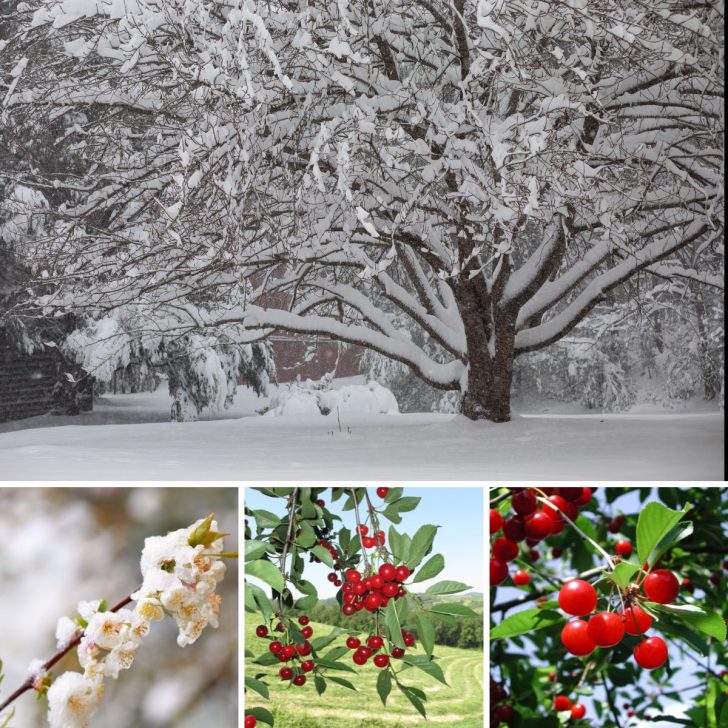Cherry trees are renowned for their delicious fruits and stunning blossoms. However, not all cherry trees are equally suited to every climate. For those living in regions with harsh winters, selecting is a cold hardy cherry tree is crucial for a thriving, fruitful tree or orchard.
Are Most Cherry Trees Cold Hardy?
Cherry trees, like all plants, have varying degrees of cold hardiness depending on their species and variety. Generally, cherry trees are divided into two main categories: sweet cherries (Prunus avium) and sour or tart cherries (Prunus cerasus).
- Sweet Cherries (Prunus avium): These are typically less cold hardy (unfortunately), compared to their sour counterparts. They thrive in USDA hardiness zones 5 through 7, though this can vary by cultivar. Sweet cherries often require more temperate conditions and are more sensitive to winter temperature fluctuations.
- Sour Cherries (Prunus cerasus): These are generally more cold hardy and can endure in more challenging climates. Many sour cherry varieties can thrive in USDA hardiness zones 4 through 6, and some even in zone 3. They are better suited for regions with cold winters and are often chosen for planting in northern areas.
- Sweet & Tart Cherries (Prunus tomentosa): The Prunus tomentosa, commonly known as the Nanking cherry, Korean cherry, or Manchu cherry, belongs to a different species within the Prunus genus. It’s neither a sweet cherry (Prunus avium) nor a sour cherry (Prunus cerasus), but rather its own distinct species.
Within these categories, there are specific varieties bred for increased cold hardiness, especially within the Prunus cerasus (sour) category.
Best Resources for Plants in Your Area
For happy trees and successful harvests, it essential to choose a variety that’s suited to your local climate conditions. Gardeners should consider their hardiness zone when selecting a cherry tree.
A gardener’s best resources are their local nurseries, especially the local businesses and mom-and-pop nurseries. Beyond that, most county extension service agents are happy to take your call, so put your tax dollars to work for you! Not only is it their job, but most agents love to talk plants and share their garden lore with you.
This article provides an alphabetical list of the best cold hardy cherry trees, ensuring your garden remains vibrant and bountiful, even in the chilliest conditions.
You can find the best time to plant fruit trees here.
Best Cold Hardy Cherries
Here’s the simple list of top cherries trees considered to be cold tolerant. The expanded information on each plant follows.
Sour Cold Hardy Cherries
- Bali Cherry (-40°F / -40°C)
- Carmine Jewel Cherry (-45°F / -42.8°C)
- Evans Bali Cherry (-40°F / -40°C)
- Meteor Cherry (-30°F / -34°C)
- Montmorency Cherry (-30°F / -34°C)
- North Star Cherry (-30°F / -34°C)
- Nanking Cherry (-38°F / -38.9°C)
Sweet Cold Hardy Cherries
- Bing Cherry (-20°F / -29°C)
- Lapins Cherry (-20°F / -29°C)
- Stella Cherry (-20°F / -29°C)
- Sweetheart Cherry (-20°F / -29°C)
Please note that these temperatures represent the estimated lowest temperature these cherry varieties can withstand. Actual cold hardiness can be influenced by a number of factors, including the specific growing conditions, the tree’s health, and its age.
Sour Cold Hardy Cherry Trees
Bali Cherry (Prunus cerasus ‘Evans Bali’)
- Scientific Name: Prunus cerasus ‘Bali’
- Common Names: Bali Cherry, Pie Cherry
- Hardiness Zones: 3-7
- US States: Widely adaptable, especially in northern states
- Life Cycle: Perennial
- Bloom Time: April to May
- Fragrance: No
- Ripens: Mid to late summer
- Pollination: Self-fertile; does not require cross-pollination
- Fruit: Tart flavor, best used in cooking and baking, especially pies and preserves
- Other Edible Parts: Leaves, root, bark, stems, pits, and twigs; leaves, twigs, roots, and bark used for teas
- Medicinal uses or benefits: High in antioxidants; supports heart health; other parts used in traditional remedies and teas for various health benefits
You may also enjoy this article on edible tree leaves.
The Bali Cherry is a resilient variety known for its cold hardiness and its production of tart, flavorful fruits that are perfect for baking, making it a favorite among pie enthusiasts.
You can find Bali Cherry at The Tree Farm Nursery

Meteor Cherry (Prunus cerasus ‘Meteor’)
- Scientific Name: Prunus cerasus ‘Meteor’
- Common Names: Meteor Cherry
- Hardiness Zones: 4-8
- US States: Particularly suited for the Midwest
- Life Cycle: Perennial
- Bloom Time: Late April to early May
- Fragrance: No
- Ripens: Early to mid-summer
- Pollination: Self-fertile; does not require cross-pollination
- Fruit: Bright, juicy cherries with a balanced flavor, suitable for fresh eating, canning, or cooking
- Other Edible Parts: Leaves, root, bark, stems, pits, and twigs; leaves, twigs, roots, and bark used for teas
- Medicinal uses or benefits: Contains vitamins A and C; anti-inflammatory properties; other parts used for various health benefits and herbal teas
The Meteor Cherry is valued for its vigorous growth and ability to withstand cold temperatures. It produces bright, juicy cherries that are versatile for culinary use, enhancing its appeal.
You can buy Meteor Cherry trees from Nature Hills Nursery, and Minnetonka Orchards.
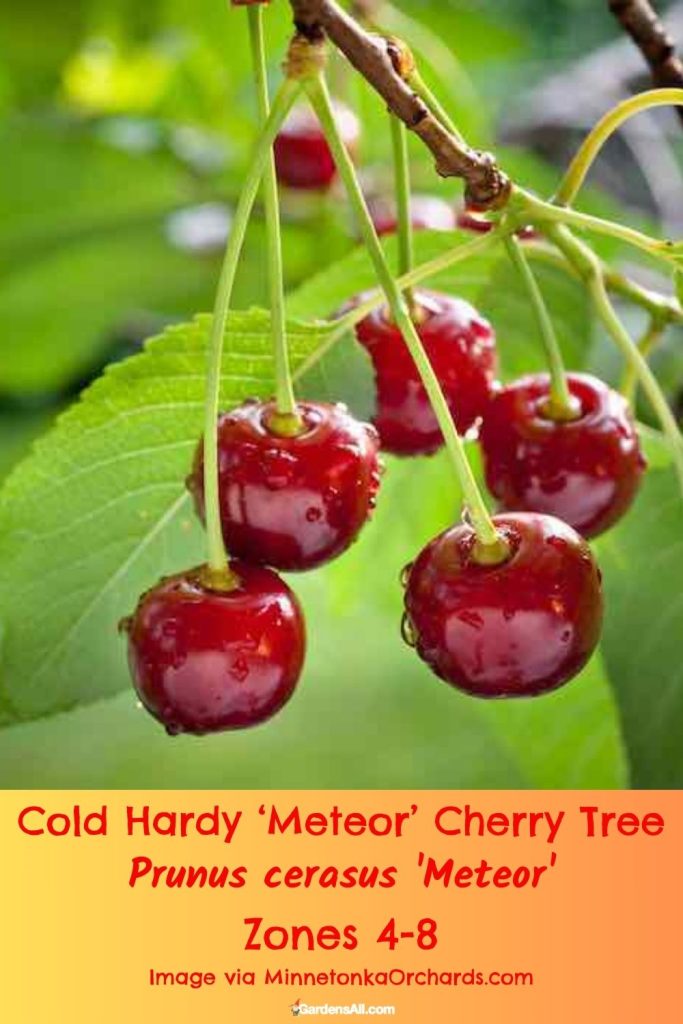
Montmorency Cherry (Prunus cerasus ‘Montmorency’)
- Scientific Name: Prunus cerasus ‘Montmorency’
- Common Names: Montmorency Cherry
- Hardiness Zones: 4-9
- US States: Grows well in most northern states and regions with cooler climates
- Life Cycle: Perennial
- Bloom Time: April to May
- Fragrance: No
- Ripens: Late spring to early summer
- Pollination: Self-fertile; does not require cross-pollination
- Fruit: Tart flavor, ideal for pies, preserves, and beverages
- Other Edible Parts: Leaves, root, bark, stems, pits, and twigs; leaves, twigs, roots, and bark used for teas
- Medicinal uses or benefits: Source of melatonin; helps regulate sleep cycles; other parts have additional health benefits and are used in herbal teas
The Montmorency Cherry, famous for its use in cherry pies, is the most widely cultivated sour cherry in the United States, appreciated for its hardiness and delightful tart flavor.
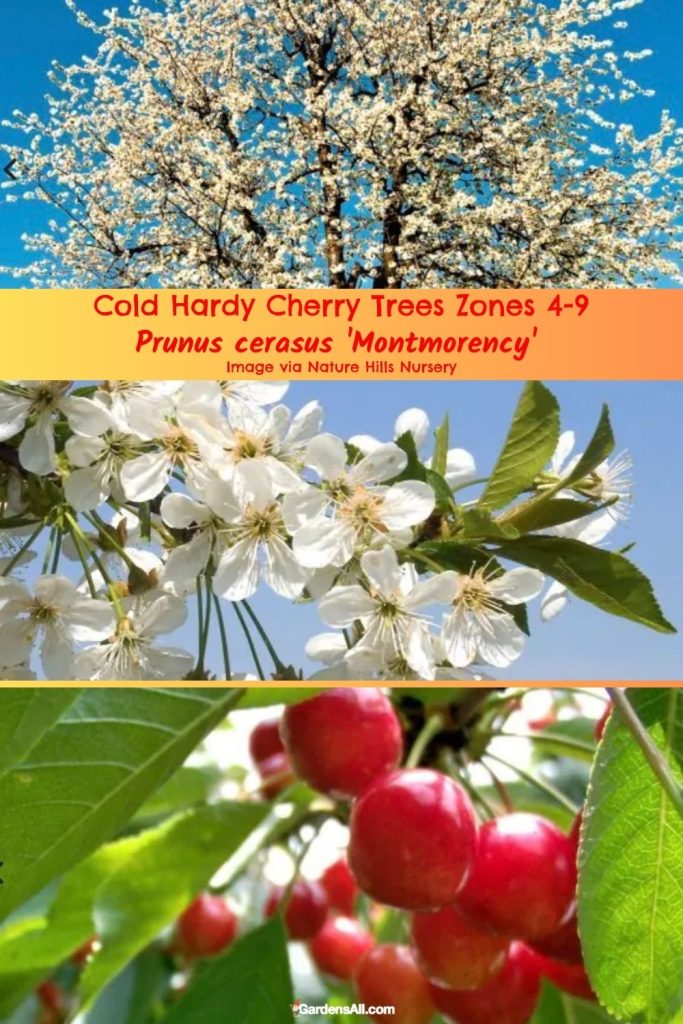
Morello Cherry (Prunus cerasus ‘Morello’)
- Scientific Name: Prunus cerasus ‘Morello’
- Common Names: Morello Cherry
- Hardiness Zones: 4-9
- US States: Adaptable, but thrives in northern climates
- Life Cycle: Perennial
- Bloom Time: Late spring (May to June)
- Fragrance: No
- Ripens: Mid to late summer
- Pollination: Self-fertile; does not require cross-pollination
- Fruit: Deep crimson, almost black fruit with a unique tart flavor, highly prized for cooking, baking, and making liqueurs
- Other Edible Parts: Leaves, root, bark, stems, pits, and twigs; leaves, twigs, roots, and bark used for teas
- Medicinal uses or benefits: High in antioxidants; promotes heart health; other parts used in traditional medicine and herbal teas
Morello Cherry is known for its deep crimson, almost black fruit with a unique tart flavor. It’s highly prized for cooking and baking, and its hardiness makes it a reliable choice for colder regions.
You can find Morello Cherry Trees at Nature Hills Nursery.

Nanking Cherry (Prunus tomentosa)
- Scientific Name: Prunus tomentosa
- Common Names: Nanking Cherry, Manchu Cherry, Downy Cherry, Shanghai Cherry
- Hardiness Zones: 2-7
- US States: Extremely cold hardy, suitable for northernmost regions
- Life Cycle: Perennial
- Bloom Time: April
- Fragrance: No
- Ripens: Late spring to early summer
- Pollination: Self-fertile; does not require cross-pollination
- Fruit: Small, flavorful fruits, eaten fresh and used in jams and jellies
- Other Edible Parts: Leaves, root, bark, stems, pits, and twigs; leaves, twigs, roots, and bark used for teas
- Medicinal uses or benefits: Contains vitamins A, C, and E; supports immune health; other parts beneficial for various conditions and used in teas
Nanking Cherry is notable for its extreme cold hardiness, able to withstand even the chilliest of climates. It’s a resilient, low-maintenance choice with small, flavorful fruits.
You can likely find Nanking Cherry Trees at your local nursery, or at Nature Hills Nursery and on Amazon.
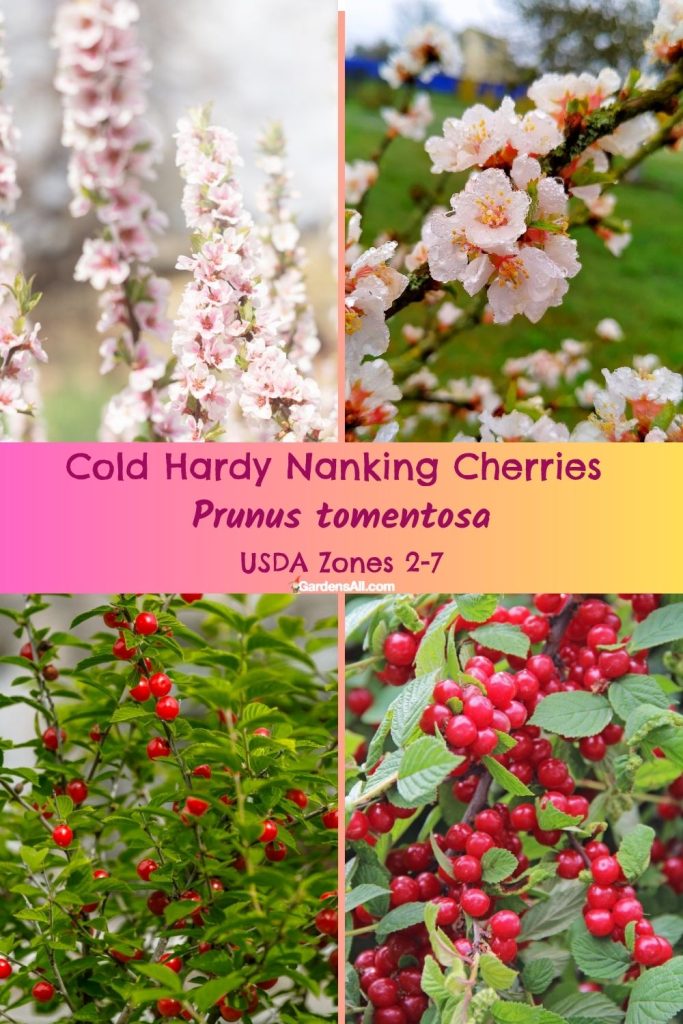
North Star Cherry (Prunus cerasus ‘North Star’)
- Scientific Name: Prunus cerasus ‘North Star’
- Common Names: North Star Cherry
- Hardiness Zones: 4-8
- US States: Adaptable across many northern states
- Life Cycle: Perennial
- Bloom Time: Mid-April to early May
- Fragrance: No
- Ripens: Early to mid-summer
- Pollination: Self-fertile; does not require cross-pollination
- Fruit: Exceptionally sweet, excellent for pies, jams, and fresh eating
- Other Edible Parts: Leaves, root, bark, stems, pits, and twigs; leaves, twigs, roots, and bark used for teas
- Medicinal uses or benefits: Rich in antioxidants; aids in muscle recovery; other parts have various medicinal uses and are utilized in herbal teas
The North Star Cherry is a compact tree ideal for small spaces, yet it doesn’t compromise on taste, offering exceptionally sweet fruit. Its adaptability and health benefits make it a worthy addition to any garden.
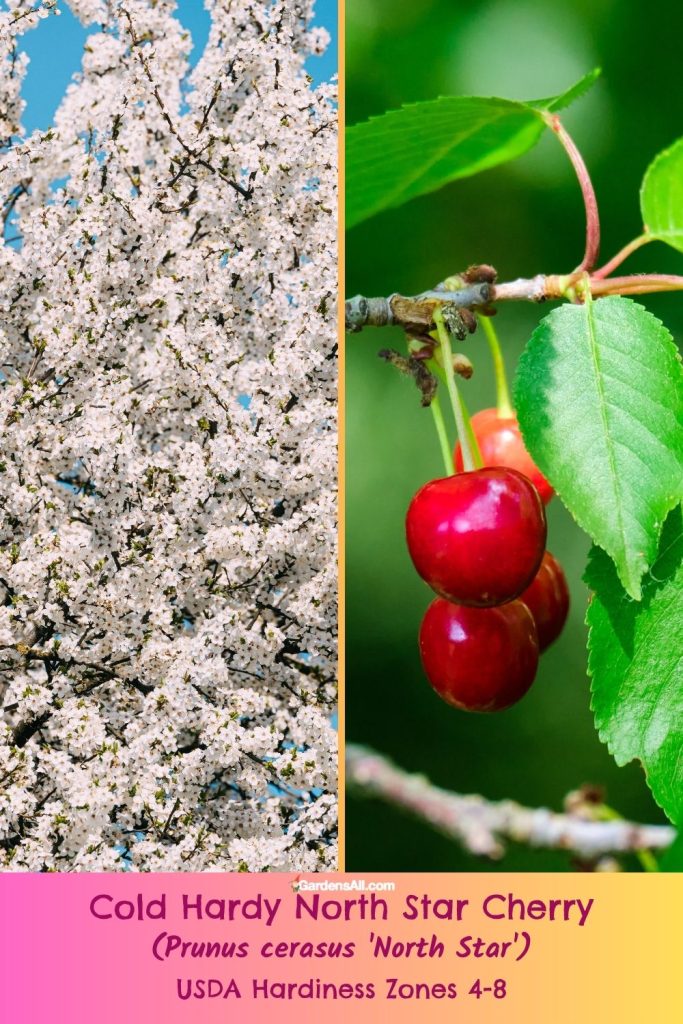
Sweet Cold Hardy Cherry Trees
Sweet cherry varieties that are known for their cold hardiness. While sweet cherries (Prunus avium) generally prefer milder climates, breeders have developed certain varieties that can withstand colder temperatures. Here are a few cold-hardy sweet cherry varieties:
Here’s a list of cold-hardy sweet cherry varieties formatted similarly to the previous list for Prunus cerasus:
Bing Cherry (Prunus avium ‘Bing’)
- Scientific Name: Prunus avium ‘Bing’
- Common Names: Bing Cherry
- Hardiness Zones: 5-8
- US States: Widely grown, particularly in the Pacific Northwest and other areas with mild winters and warm to hot summers.
- Life Cycle: Perennial
- Bloom Time: Mid-spring
- Fragrance: No
- Ripens: Late spring to early summer
- Pollination: Requires cross-pollination from another compatible cherry variety
- Fruit: Large, dark red to purple cherries, known for their sweet, rich flavor, excellent for fresh eating
- Other Edible Parts: Not commonly consumed
- Medicinal uses or benefits: High in antioxidants, anti-inflammatory properties, and may offer other health benefits related to heart health, sleep, and exercise recovery.
If you’re in USDA hardiness zones 5-8 the Bing Cherry is virtually a national favorite. while not especially cold hardy below zone 5, it’s included in this list due to its popularity and status as one of the most classic and beloved sweet cherries.
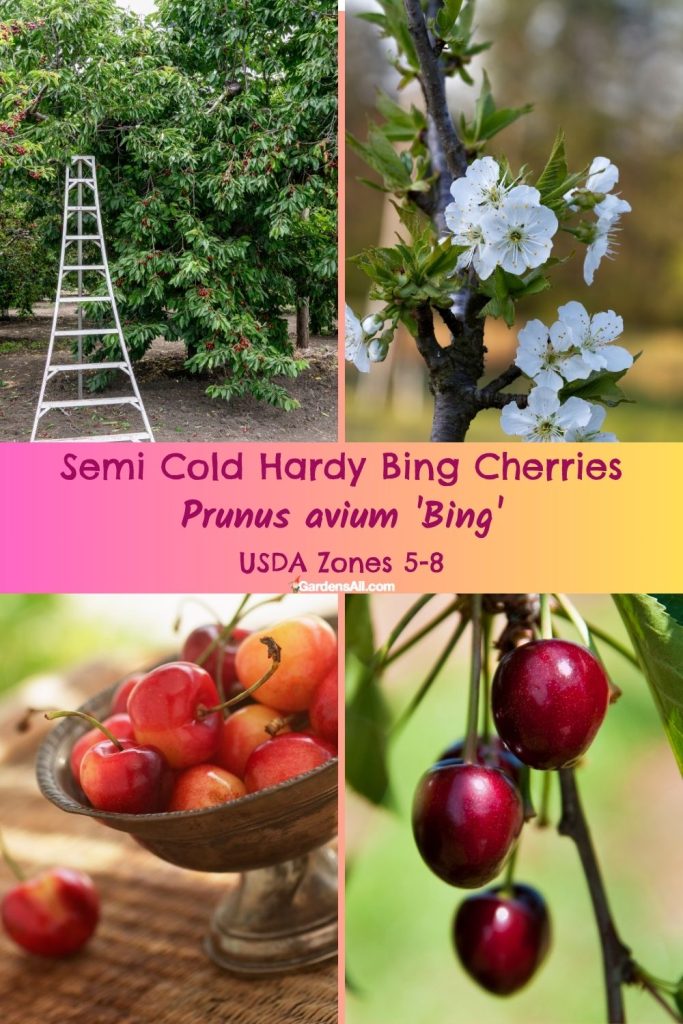
Lapins Cherry (Prunus avium ‘Lapins’)
- Scientific Name: Prunus avium ‘Lapins’
- Common Names: Lapins Cherry
- Hardiness Zones: 5-9
- US States: Versatile and can be grown in a variety of regions with colder winters
- Life Cycle: Perennial
- Bloom Time: Late spring
- Fragrance: No
- Ripens: Mid to late summer
- Pollination: Self-fertile; does not require cross-pollination
- Fruit: Large, sweet cherries with a dark red to purple color, suitable for fresh eating
- Other Edible Parts: Not commonly consumed
- Medicinal uses or benefits: Contains vitamins, minerals, and antioxidants; supports heart health
Lapins Cherry is noted for its large, flavorful fruits and its ability to thrive in areas with significant temperature variations.
You can purchase Lapins Cherry Trees from Nature Hills Nursery and from Amazon.
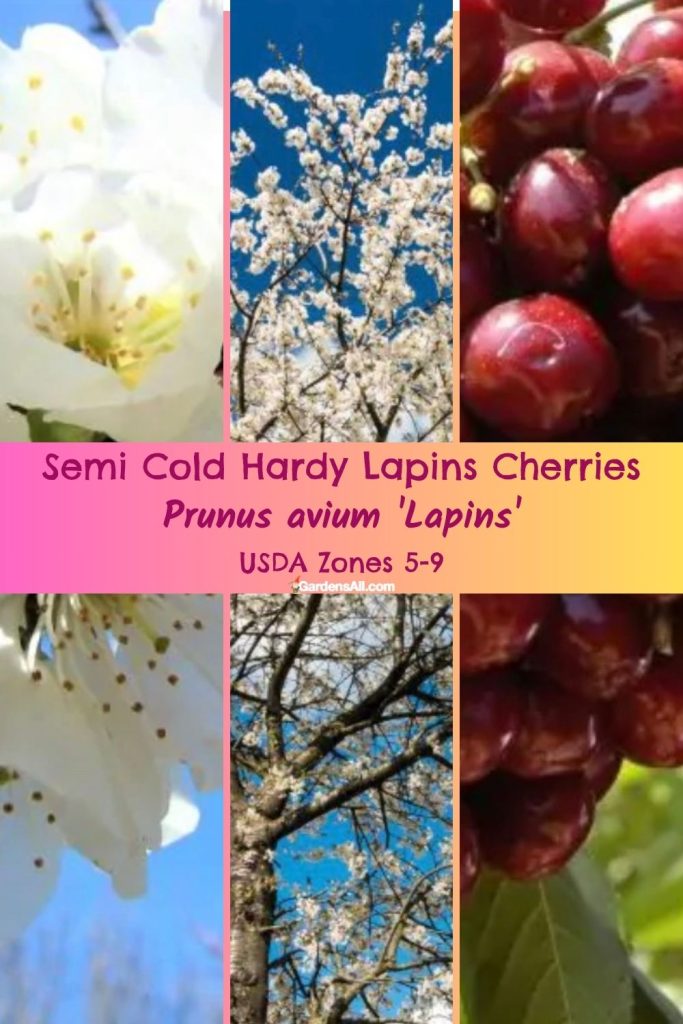
Stella Cherry (Prunus avium ‘Stella’)
- Scientific Name: Prunus avium ‘Stella’
- Common Names: Stella Cherry
- Hardiness Zones: 5-8
- US States: Adaptable to various regions, particularly suited for areas with milder winters
- Life Cycle: Perennial
- Bloom Time: April to May
- Fragrance: No
- Ripens: Mid-summer
- Pollination: Self-fertile; does not require cross-pollination
- Fruit: Sweet, dark red cherries, excellent for fresh eating
- Other Edible Parts: Not commonly consumed
- Medicinal uses or benefits: High in antioxidants, anti-inflammatory properties
The Stella Cherry stands out for its self-pollinating characteristic and is a favorite among gardeners who wish to grow sweet cherries in regions with cooler climates.
You can find Stella Cherries at Nature Hills Nursery and on Amazon.
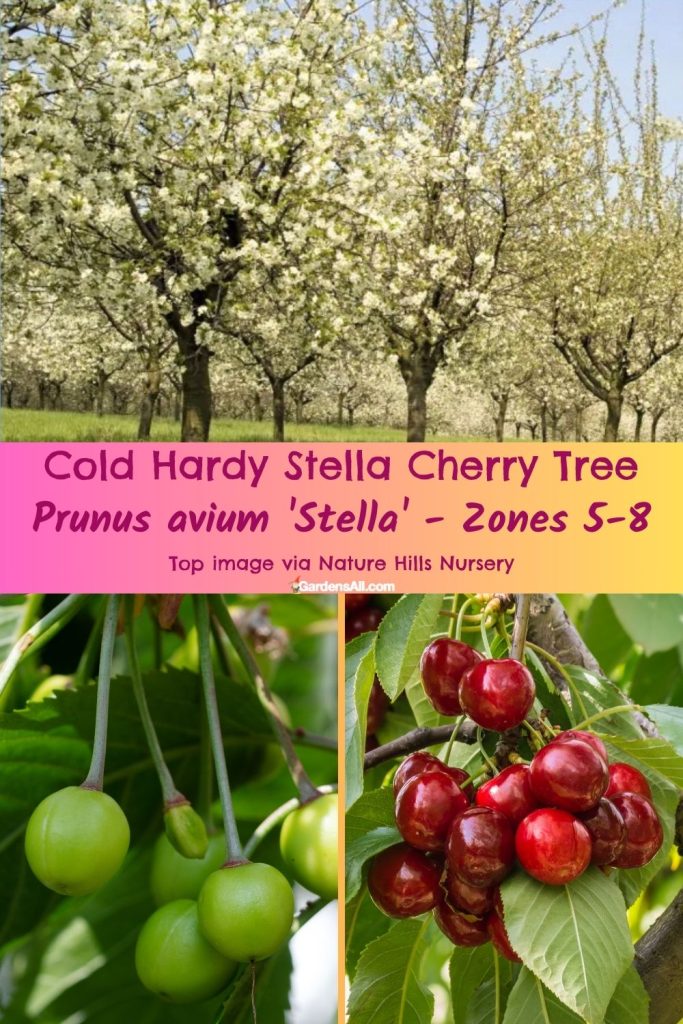
Sweetheart Cherry (Prunus avium ‘Sweetheart’)
- Scientific Name: Prunus avium ‘Sweetheart’
- Common Names: Sweetheart Cherry
- Hardiness Zones: 5-9
- US States: Adaptable, good performance in regions with cold winters
- Life Cycle: Perennial
- Bloom Time: Early to mid-spring
- Fragrance: No
- Ripens: Late summer
- Pollination: Self-fertile; does not require cross-pollination
- Fruit: Sweet, rich flavor with a bright red color, excellent for fresh eating
- Other Edible Parts: Not commonly consumed
- Medicinal uses or benefits: Rich in vitamins, antioxidants, and anti-inflammatory compounds
The Sweetheart Cherry variety is celebrated for its late ripening, allowing growers to extend the cherry season, and its significant cold hardiness makes it suitable for cooler regions.
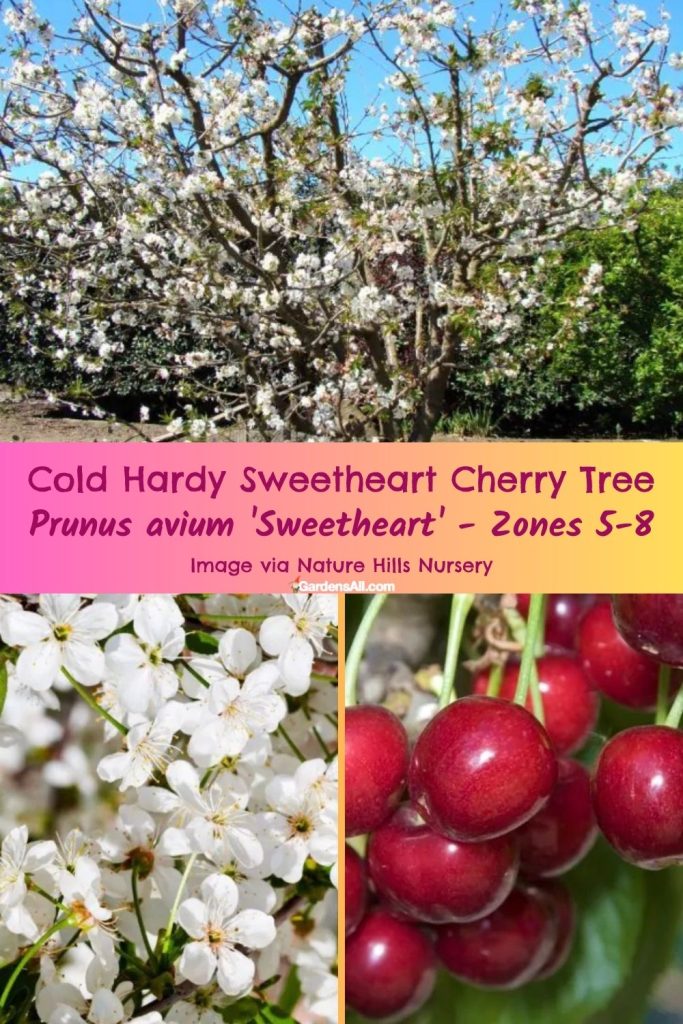
In Summary
These cold hardy cherry trees not only promise beauty and bountiful harvests but also offer various health benefits, making them a fantastic choice for gardeners in cooler climates.
However, when selecting a cherry tree, it’s important to always consider not only cold hardiness but also other factors like soil conditions, chill hours, heat tolerance, and potential disease issues in your area. Consulting with a local nursery or cooperative extension service can provide valuable guidance tailored to your specific location.
I’m LeAura Alderson, a garden, herb and plant enthusiast with a passion for discovering the many edible and medicinal benefits of the plants all around us, including the weeds! I’m a writer, editor and media publisher for our family of websites.
While I was certified in fitness and life coaching, I am NOT a health practitioner. However, I’m a lifelong health enthusiast, with a keen interest in healthy, organic foods and making home remedies and the content we share is from our own experience and usage as well as that extracted from scientific research so that you can explore further on your own.
Always seek the advice and guidance of your health practitioners first and foremost.
As a family we’re steadily expanding our gardening, experimentation and knowledge around all things gardening, edible landscaping, fresh organic foods and self sustainability with farming in our future. I also own and manage iCreateDaily.com, a site all about transformation through creation, and the power of positivity, optimism and mindset.

